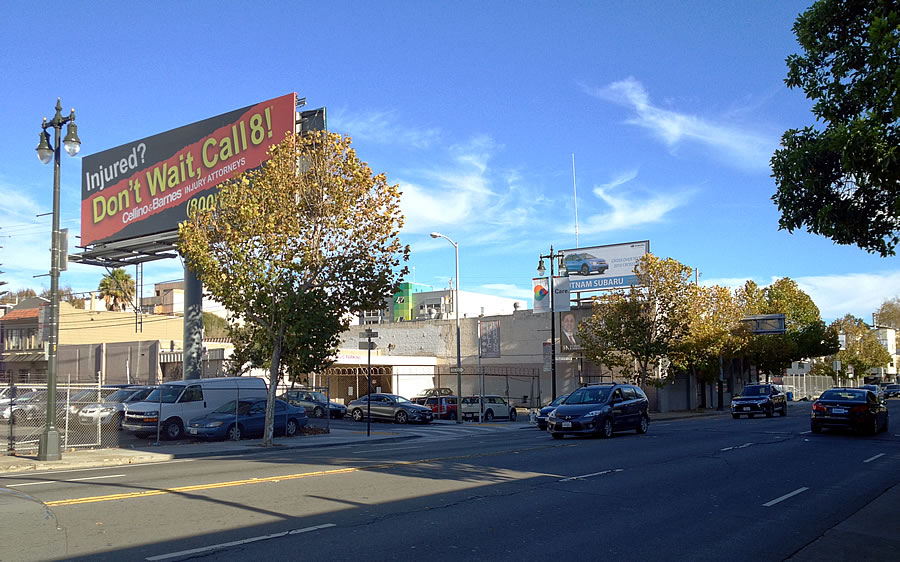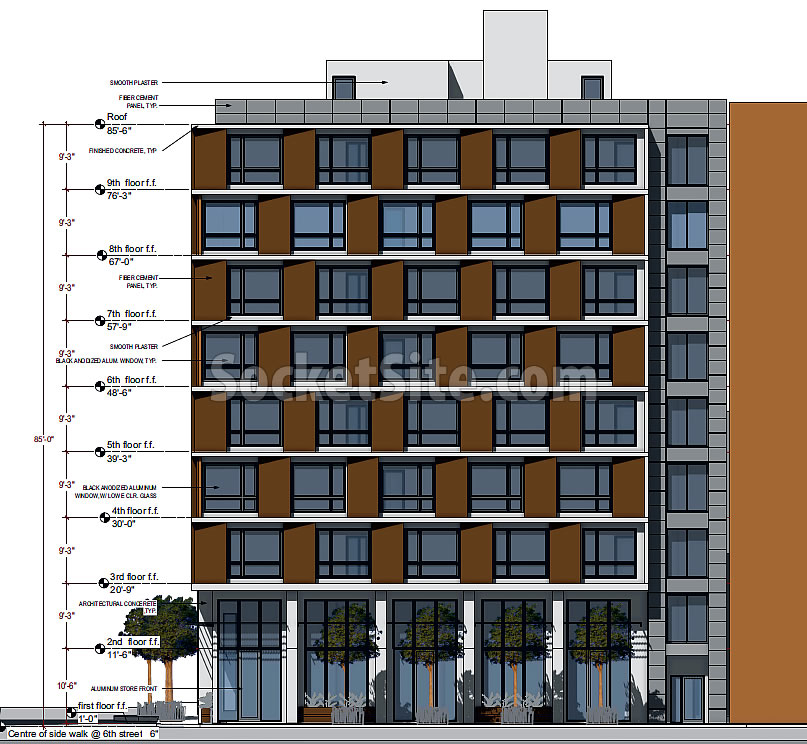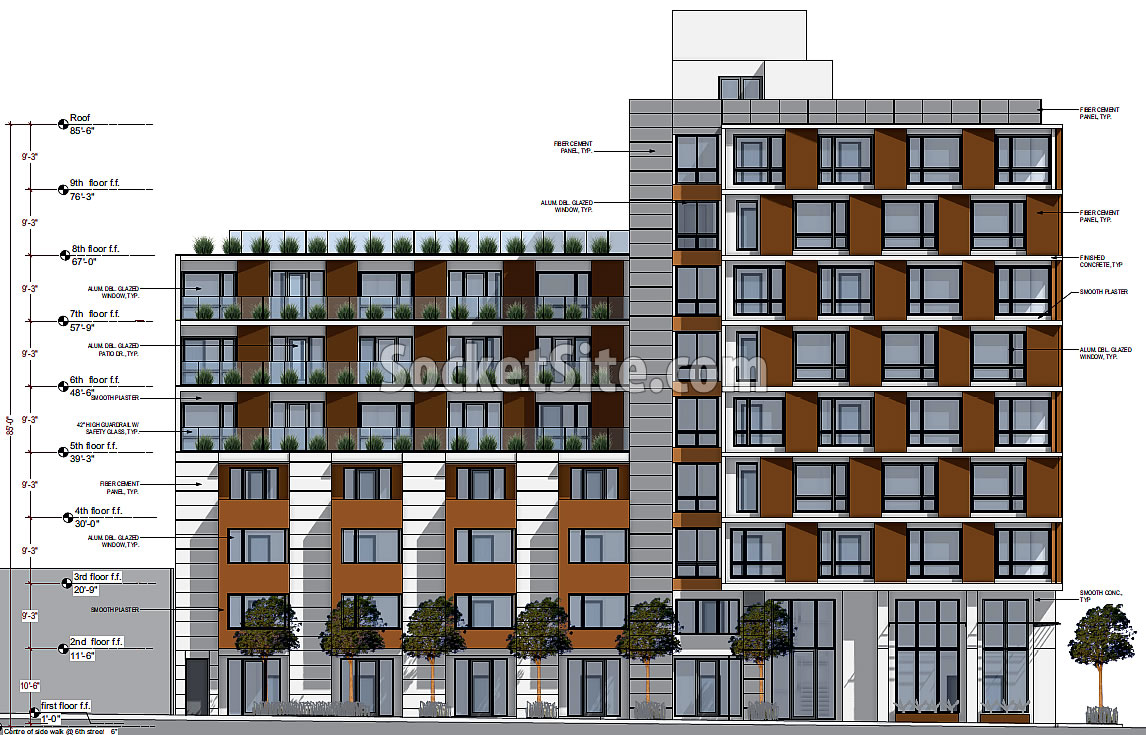
Approved for a 5-story building with 36 condos over a ground floor of commercial space back in 2009, but then waylaid by a stated inability to secure financing, new plans for a 9-story building with 102 single-room occupancy (SRO) units, each with its own kitchenette and bathroom, to rise on the southeast corner of Sixth and Shipley have been drawn.
The 85-foot-tall building, which is measured to the roof, would step down along Shipley and includes 1,700 square feet of commercial space and a storage room for 103 bikes on its ground floor.
If the proposed building’s projected shadow is found to be acceptable with respect to its impact on the nearby Gene Friend Recreation Center at the corner of Sixth and Folsom, the cumulative shadow limit for which is slated to be raised in order for the building to rise, the 345 6th Street project could be approved in three weeks time.
That being said, an eight-story building has been approved to rise up to 85-feet in height on the adjacent 363 Sixth Street parcel as well as another at 377 6th Street (across from the End Up at the corner of Harrison Street), but both those projects are now on the market seeking buyers for the entitled development sites.


Are SRO units exempt from the 25% subsidized-affordable requirement? Otherwise, I wonder why they wouldn’t build traditional studios.
SRO dwelling units are similar to studio apartments, however, the SRO designation can allow for a reduced open space requirement (in some zoning districts) and there is no 40% 2-bedroom requirement. In most cases, the SRO dwelling unit must be larger than 275 sqft and smaller than 350 sqft excluding the private bathroom. THEY ARE NOT EXEMPT FROM BMR REQUIREMENTS.
So only people who meet BMR requirements will be able to purchase one? OR, will these be simply zoned as SRO but sold at market rate?
I presume these are affordable housing SRO’s/supportive housing and not tech worker dorms. What developer builds SROs?
[Editor’s Note: That’s incorrect. If so, we would have noted and tagged “affordable” and/or “below market rate (BMR)” above.]
Thank god it’s not projects. We really don’t need any more of those. Tech dorms will bring a modicum of civilization to the dangerous and disgusting wasteland that area is.
+1 The area needs tech worker dorms. So glad they’re coming to my neighborhood….
parking?
Residential Parking Area U, which entitles them to hundreds of street parking spots scattered from South Park to McCoppin St, many of them unmetered.
Hundreds already filled up. They will be circling the blocks, adding to the excitement of the rush hours. What a clever example of city planning!
Driving in that area would be stupid to begin with. Go to Walnut Creek if you want a parking spot.
Yeah, nobody drives around 6th and Harrison, too congested. Not like owning a car there would increase access to the large job markets along 101 and 280 or on the Jersey side of the bay. and look how far you have to go just to buy gas, get new tires, find a mechanic/bodywork/carwash, or get your window fixed after another breakin from parking overnight on the SoMa streets. Almost as bad as the killer hike to an urban area from the Canton of Noe Village. Nah, “that area” is just not conducive to driving and car ownership, only the really really stupid can’t see when the futility is so much greater than the utility.
@Jake:
No, you’re right. Living there, and owning a car with your own parking space, would work well for many people. Question is, does the city benefit from having more car owners living there, or more non-car owners? Should the city encourage/allow an unlimited number of parking spaces/cars? What if traffic is terrible? Should the city allow even more car owners? Should it allow more units for non-car owners?
Alai, SF has no power to disallow car ownership. Car ownership is increasing in SF both in total numbers and cars per person. That is what happens with rising incomes and has been happening since these useful gadgets were invented. I would think SF benefits from having residents with incomes high enough to own cars, though God so loves the poor that they will always be among us.
If future residents at this location want to own cars then they can and if they want to park them on the street, then they can. Sheesh, when they have self-driving cars (in a Tesla-Friedman unit or two) they can send them out to roam until they find free parking, maybe on your block. Public streets and all.
The traffic there isn’t “terrible” because of the density of residential car ownership. The congestion is due to the enormous number of car commuters that drive between their distant homes in other counties and other SF neighborhoods via the nearby freeways and on to the downtown parking garages/lots. And about half of these commuters get free parking, according to a survey done by UCB for the Bay Bridge. If no one for blocks had a car it would hardly make any difference to the several hours per workday of commute-time ‘terrors’ of the traffic around 6th and Harrison.
“Unlimited number of …” implies potentially infinite, which is not physically or financially possible, thus the question is absurd.
The real question is how can a city solve traffic problems when so many people misdirect the effort with wrongheaded questions?
are you joking. there are more than 400,000 cars in SF.
Why does every post on socketsite devolve into a rant about parking? SF gave up on parking in high density areas a long time ago.
I have yet to see a coherent theory on why discouraging car ownership by reducing availability of parking is bad policy. Of course it creates demand for on-street parking, but that’s the whole point. the policy is designed to make it difficult so that only the most determined can afford the time to find parking on a daily basis. I’ll wager there is a tipping point to the avg person’s patience in circling the block to find parking. At some point, they will either find a way to live without a car, or move somewhere else. Why is that a bad thing?
If its cultural, then move to a place that facilitates car ownership–the other 99.9% of America.
I’ll go one step further. Why should solving car traffic gridlock even be a priority? If what you say is true about rising incomes equaling more cars (and I am not sure it is), won’t improving gridlock simply make daily car commuting a viable option for more people? That to me is in-apposite to a transit first policy. Personally, I’d like to see even more gridlock, with fewer lanes of speeding traffic, with cars moving at a measured pace, with bigger sidewalks, with more bus only lanes that are actually enforced, and with protected bike lanes.
Reducing traffic congestion is in everyone’s best interest for many reasons, including health, safety, and wasted time costing billions in lost productivity. You can have your entire list of desires without congestion. And you shouldn’t expect to get many more bike lanes unless we get a lot more cars off the road, not by turning our streets into massive gridlock, but by making it more expensive in $$$ to drive where and when it is congested. The simplest way in the SF CBD is just to raise the cost of parking, as we already have mechanisms to collect and they are easy assets to track. The key usage to target is commuters, which make up at least half of all the vehicles in the SF CBD during the worst congestion.
But yeah, just discouraging the residents of the tiny increment of new housing we build will have a nearly zero impact on congestion because we already have enormous parking facilities for commuters. A feel good “do gooder” restriction, but ineffectual. Basically, the existing commuter parking facilities are far greater than the flow capacity of the road/bridge/fwy network, thus commute time congestion. Unless you think somehow SF is really going to give up “on parking in high density areas” by demolishing or restricting tens of thousands of existing parking garage spaces in FiDi and SoMa.
And sorry if any of this seems like a “rant”, but the idiocy burns. And, btw, I have previously demonstrated on SS that car ownership in SF increases with income.
How big are the units? Are they “micro”?